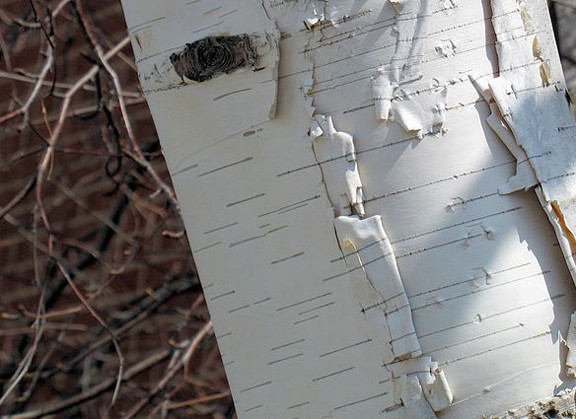Trees provide more than just shade or materials to build a shelter.
In a survival situation, they can be literally life-saving. Here are a few of the most common and how they can be used.
1. White birch (paper birch)
• Sweet drinkable sap that does not need purification
• Containers can be fashioned from the bark (and even canoes – hence the name “canoe birch”)
• It’s papery bark makes some of the finest fire starting tender on the planet, which will light even when damp because of its resinous quality
• A fine tea can be made from the small twigs at the end of a branch or by shaving the bark from new growth. Toss a palmful of these elements into boiling water for a fresh, wintergreen-flavored tea
• The tinder fungus (chaga) grows almost exclusively on the white birch tree. The fungus is one of the only natural materials I know of that will take the spark from flint and steel. A piece of tinder fungus along with flint and pyrite to create sparks were even found on Otzi, the “iceman” who was uncovered in the Austrian Alps several years ago.
• Pine tar can be extracted from the bark of the white birch by heating it over a fire. Pine tar makes an excellent natural adhesive which natives used for all kinds of purposes including securing stone points on arrows.
2. White Pine
• Resin can be used a fire extender when mixed with tinder material
• Resin can be heated and mixed with crushed charcoal to make a natural epoxy
• Resin-rich joints and stump pieces make incredible fire kindling
• Make pine-needle tea from the green pine needles – very rich in Vitamin C
• Inner bark layers are edible
• Harvest pine nuts from the pine cones
• Pine needles make excellent fire tinder
• Pine needles make excellent natural insulation material for debris huts and survival shelters
• Green pine boughs are perfect for lean-to shelter roofs
• Green pine boughs are great for making a ‘pine bough bed’ to protect from the cold ground or snow
• The lower, dry, dead branches of the pine tree (squaw wood) is often some of the driest fire kindling available. It is exposed to the wind and also protected from the elements by the year-round needle canopy above, I’ve also used these branches for making bow drill fire friction sets.
• Very effective candles and lamps can be made from pine resin
• Pine resin can be used to waterproof seams in clothing or crude containers
• The very pliable surface layer roots make excellent (and strong) natural cordage. Use as a whole or split into smaller pieces.
3. Sugar Maple
• In later winter/early spring when the sap is running, the sugar maple is an excellent source of drinkable water (sap) that needs no purification. Maple Sap is nature’s version of an energy drink – rich in sugar and nutrients. I’ve filled a 1-liter canteen in as few as 15 minutes before. Maples don’t have fully developed (or any) leaves during this time of year – hence the important of 4 season identification.
• The seeds inside the little helicopters are edible, just like edamame. I just boil them and lightly salt. They can also be fried or added to stews. Remove the outer helicopter.
• I almost always use maple branches for wilderness cooking. Whether it’s a spit roast, a hot dog stick or utensils, I can always find a maple branch suitable for the task. Maple branches naturally have a lot of forks, which is great for pot holders and other wilderness kitchen uses. I also use the leaves to wrap fish or other small game animals when cooling in an earth oven.
• Young maple leaves are also edible. Toss them into a salad or boil them down with other spring greens. They get bitter and rough as they mature.
These are just three of the most common trees that can be found virtually anywhere in the US or Canada, but just about every tree has benefits in addition to being used to build shelter or provide shade.
In fact, given their prolific nature, trees are one of the most useful components in nature in a survival situation.
To learn more on how trees are a survival tool and to learn how to use them, please visit Willow Haven Outdoor.

@[1823320764:2048:Jace Hargrove] @[100000124222667:2048:Charles Neil Prestwood] @[184104330:2048:Stephanie Holmes Watkins]